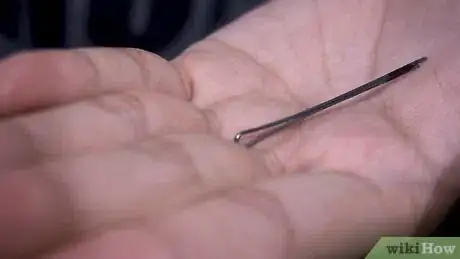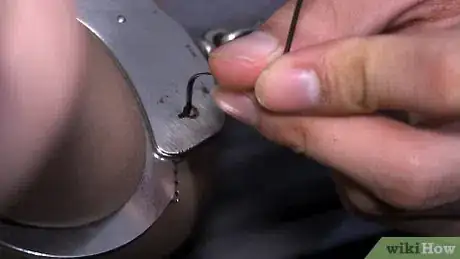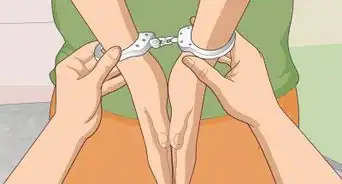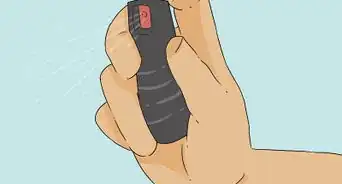This article was co-authored by wikiHow Staff. Our trained team of editors and researchers validate articles for accuracy and comprehensiveness. wikiHow's Content Management Team carefully monitors the work from our editorial staff to ensure that each article is backed by trusted research and meets our high quality standards.
There are 8 references cited in this article, which can be found at the bottom of the page.
The wikiHow Video Team also followed the article's instructions and verified that they work.
This article has been viewed 1,381,333 times.
Learn more...
If you find yourself in a situation where you need to escape handcuffs, it is entirely possible to do so using ordinary objects. Handcuffs have standard locking mechanisms that can easily be unlocked with a makeshift key or shim. Using a makeshift key is an intricate process but it carries less risk than using a shim, which may result in tighter restraints. Zip ties have a similar locking mechanism as handcuffs, but they can also be broken if you put enough pressure and force into them.
Steps
Escaping Handcuffs with a Makeshift Key
-
1Find a bobby pin, paper clip, or piece of wire. To create a makeshift key, you will need a thin, bendable piece of metal. Look around you to locate a bobby pin, paper clip, or piece of wire. Be sure that the wire is strong enough to act as a key.[1]
- If you are using a bobby pin, be sure to remove the plastic tip if there is one.
-
2Straighten out the metal. If you are working with a bobby pin, use your thumb and forefinger to pull apart its two sides to straighten it out. If you are using a paper clip, brace the middle between your fingers on one hand and use the other hand to pull it open to make a straight piece of wire. Uncurl or unbend any other type of wire you may be using.Advertisement
-
3Bend the tip of your bobby pin, paper clip, or wire. Hold the end of your strand of metal between your two index fingers. Position one finger about a quarter of an inch (approximately 0.6 cm) down from the tip. Use the other finger to bend the top of the metal into a 90 degree angle.[2]
- The bent tip of your makeshift key should only fit halfway into the handcuff lock.
-
4Place the tip into the keyhole and bend the metal backwards. Using your fingers, feel around to find the keyhole on the handcuffs. Direct the tip of your makeshift key inside of it. Once you've inserted the tip all the way into the lock, bend your key backwards to make another 90 degree angle.[3]
- Remove the key to feel it. The end of your key should now be in a sort of "Z" shape.
-
5Insert the "key" in the hole. Find the hole again with your fingers. Wiggle the bent part into the hole so that it points toward the locking arm. It should be at a 90-degree angle to the keyhole.[4]
-
6Twist the key in different directions. Twist the key in different directions. Eventually the key should should lift the locking device inside and click the cuffs open. Be patient during this process as it may take some time.[5]
-
7Unlock an extra lock for double-lock handcuffs. Double-lock handcuffs are essentially regular handcuffs with an extra locking mechanism for added security. To get out of these, inset your makeshift key into the lock, pointing away from the center of the handcuffs. Twist the key until you feel a slight click, then remove the key and re-insert it the other way to unlock the basic locking mechanism.
Escaping Standard Handcuffs with a Shim
-
1Find a flat piece of metal. Find a piece of metal that is about as thin as a credit card. This "shim" should be narrow enough to fit into the locking mechanism on the cuffs. The metal clip on a pen could serve as a "shim," for instance.[6]
-
2Insert the shim between the locking mechanism and the teeth. Slide your shim up into the locking mechanism so that it runs along the teeth. You're essentially sticking the shim into the cuff along the rim. If your hands are behind your back, feel around slowly to locate this point and insert the shim carefully.[7]
-
3Tighten the cuff and push the shim. With the shim in place, tighten the cuff one notch. Push the shim forward as you tighten the cuff. Note that if you fail to unlock the handcuffs this way, you will end up restrained more tightly than before.[8]
- If you are successful, the handcuffs should click open.
Escaping Zip Ties
-
1Use your teeth to tighten the zip tie, then break it. Brace the loose end of the zip tie between your teeth. Pull the strand of plastic upwards towards you, tightening the tie. As you pull it tighter, try to break the tie apart with your wrists.[9]
- The tightness should create a tension in the tie that makes it easier to break.
-
2Use a shim to override the locking mechanism. Insert a small object into the locking bar of the zip tie. Once the locking bar is separated from the locks of the zip tie, you should be able to remove the tie from the locking mechanism. Try to use your fingernail, a small pin, a credit card, or anything else you can find.[10]
- The locking mechanism is essentially a small notch that digs between the tracks of the zip tie as you tighten it, keeping it secured.
-
3Use your shoelaces to "saw" through the zip tie. If your hands are tied in front of you and you are wearing shoes with laces, reach down and untie them. Use your fingers and teeth to thread one shoelace though the zip tie. Attach it with a knot to a shoelace from your other foot so they connect between your wrist and the tie. Lift up your feet and kick your feet back and forth until the lace "saws" through the zip tie.[11]
Community Q&A
-
QuestionWhy would someone need to know how to do this?
 Community AnswerSomeone might need to know this if they were kidnapped, or maybe if a friend played a prank on them by putting them in handcuffs and leaving them like that.
Community AnswerSomeone might need to know this if they were kidnapped, or maybe if a friend played a prank on them by putting them in handcuffs and leaving them like that. -
QuestionHow can I tighten the zip tie if it is behind my back?
 AbbsTheCrabbsCommunity AnswerFeel for the end, then grasp it with two fingers and pull. Make sure you're actually pulling on the end and not the loop.
AbbsTheCrabbsCommunity AnswerFeel for the end, then grasp it with two fingers and pull. Make sure you're actually pulling on the end and not the loop. -
QuestionWhy am I always able to squeeze my wrist through handcuffs?
 Community AnswerBecause they weren’t locked down tight enough. A properly applied handcuff can't be taken off by squeezing your hand through.
Community AnswerBecause they weren’t locked down tight enough. A properly applied handcuff can't be taken off by squeezing your hand through.
Warnings
- Do not try to escape from handcuffs while in custody.⧼thumbs_response⧽
References
- ↑ https://mastermindescapegames.com/escape-room-atlanta/
- ↑ http://www.artofmanliness.com/2012/02/22/how-to-pick-your-way-out-of-handcuffs/
- ↑ http://www.survivalsullivan.com/how-to-get-out-of-handcuffs-and-other-restraints/
- ↑ http://www.itstactical.com/skillcom/lock-picking/how-to-pick-your-way-out-of-handcuffs/
- ↑ http://www.survivalsullivan.com/how-to-get-out-of-handcuffs-and-other-restraints/
- ↑ http://www.atlasobscura.com/articles/how-to-escape-from-handcuffs
- ↑ http://www.atlasobscura.com/articles/how-to-escape-from-handcuffs
- ↑ http://www.atlasobscura.com/articles/how-to-escape-from-handcuffs
- ↑ http://www.artofmanliness.com/2014/03/27/3-ways-to-escape-zip-ties-an-illustrated-guide/
































































